I’ve always been deeply ambivalent about the real place called Hollywood and about Los Angeles in general. When I first flew out for a visit, about 1970, I had a window seat and during our low approach to LAX I looked out over mile after flat mile of superblocks divided by major streets, all viewed as if through a light chartreuse filter. This was before clean air laws and mandated emissions controls on cars. The air burned my eyes on two occasions during my week-long stay, and I wondered how so many people could live there seemingly satisfied with conditions I could hardly tolerate. Fast forward about 40 years and I’m still not in love with L.A., but I do manage to have fun when I’m there.
This photo was snapped in February 2007 during the week before the Oscars were handed out. Hollywood Boulevard was closed to traffic for many blocks around the Kodak Theater, creating snarls and backups on all the other major roads, but I was able to find and park in one of three lots adjoining the back of the Hollywood Wax Museum so I could attend one of the screenings in a festival showcasing new Italian films at Grauman’s Chinese, on the same crowded block as the Kodak. When I got back to the car, night had fallen and the lights were on, and I knew I had to preserve this vision of Hollywood, a company town where billboards touting new product seem bigger and more numerous than anywhere else in the world, and where every actor hopes to achieve the immortality of John Wayne, Elvis Presley, Marilyn Monroe, Charlie Chaplin. I was especially taken with the way the museum’s mural incorporates the utility lines on the sides of the building. Nothing gets in the way of promotion in Tinseltown.
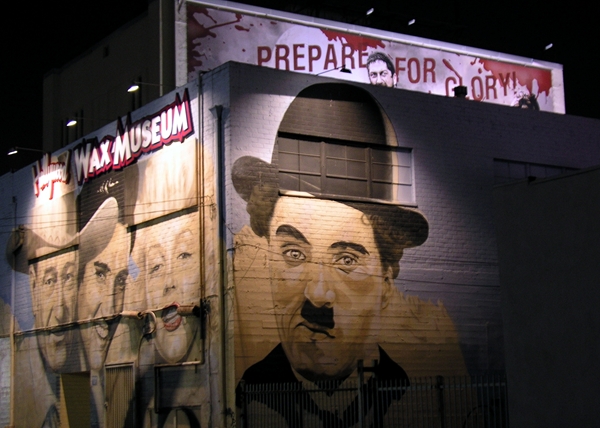
You’re invited to my first solo show, on the walls during the whole month of June at Made With Love Artisan Bakery & Cafe, in Downtown Jersey City. An opening party is planned for Saturday, June 5, from 7 to 9 p.m. Susan Newman designed my postcard. 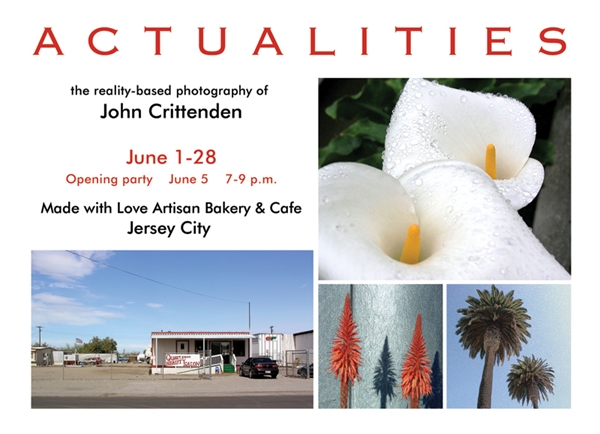
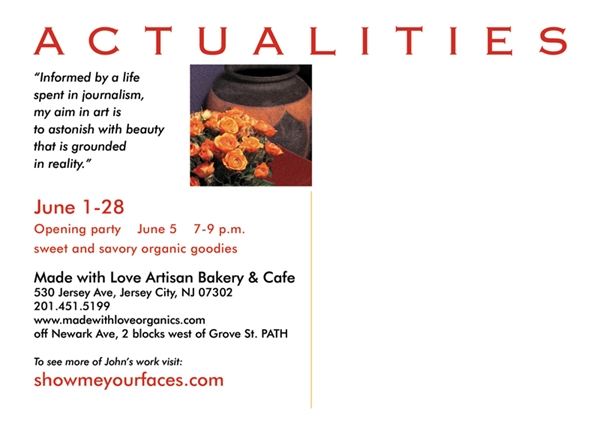
During a recent trip to Oklahoma to reconnect with my native state, I had just visited the little town of Perry, a few miles east of I-35, and was heading due east on my way to a left turn that would take me straight north to Ponca City, when a biker flew past me. Impulsively, I tried to keep up and photograph him at the same time. (Autofocus makes this possible, but I don’t recommend it in heavy traffic.) I drove above 70 mph, and sometimes hit 80, and followed him for miles but never got close, and then came over a hill and he was gone from sight. But I’ve got this to remind me of Oklahoma’s big sky and wide open spaces, where the air is clean and you can see for miles.
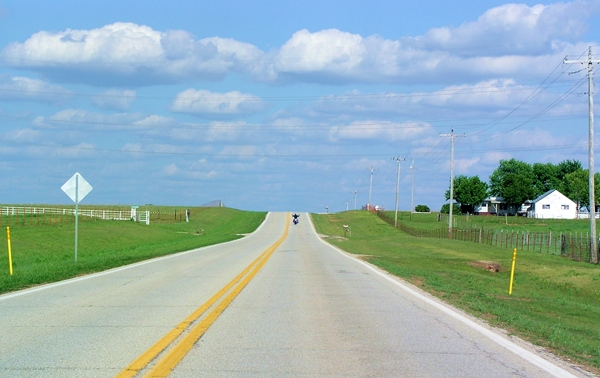
Perhaps my life as a photographer would be easier, or at least lighter, if I were more comfortable with certain conventions. I well remember when photographs weren’t considered serious unless they were black and white and presented in a white or cream mat behind glass inside a black wood or metal frame. Later, natural wood frames became acceptable, and now white wood frames are seen everywhere. I understand some of the reasoning. You’re supposed to be presenting the photo, featuring it while protecting it, and there should be nothing distractingly different in a room that contains eight or ten or a dozen photographs. Each image should be a focus and nothing should take away from it. I do get that. But there are so many options available today that I can’t accept uniformity as any kind of operating principal. Not with photographs being printed on metal, on plastic, on canvas, and on other media. And so I wrestle with deciding how I want to see every particular image on a wall.
Below is a photograph I took in southwestern Pennsylvania only a few miles north of the border with Maryland. We are looking out to the porch and trees beyond a roadway from inside the Stone Inn, a circa 1822 building on the Braddock Road, which dates from the 1750s and was incorporated into one of the nation’s first improved highways built by the federal government. Started in the early 1800s, what became known as the National Road carried multitudes of settlers and travelers from Baltimore west to Ohio. Now a large and comfortable restaurant with a bed and breakfast operation upstairs, the inn has always been a stopping place for rest and hospitality. I found the dining room to be one of those places with a pleasant, calculated historic feel but no particular antique vibe. I found the outside view compelling. The thrill, if you feel it, is in looking out over a byway that’s been busy with commerce every single day for centuries and a landscape that has hardly changed except as it grew and died back and then renewed itself. I wanted to somehow capture that, without being too literal or stuck in any particular year.
After much debate with myself, I had this photograph printed large and on canvas, and it drew many favorable comments in my first solo show of my work, in June at Made With Love Artisan Bakery & Cafe in Downtown Jersey City. Looking out across time is someting many of us enjoy doing, and this will add an architectural element to any wall it’s on.
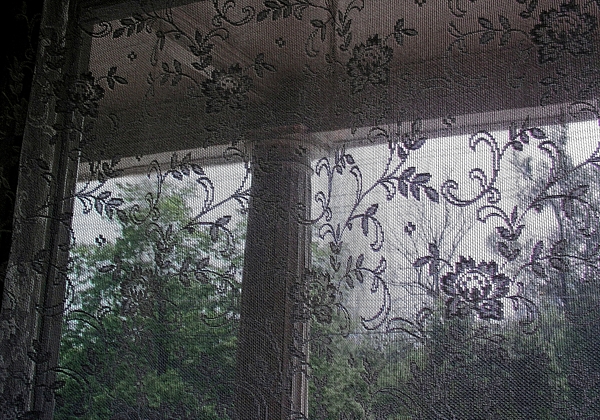
We’re a fan of good headlines. I spend a good bit of my work time each week writing them for a daily newspaper, and in fact I’ve just taken first place — for the second time — in the New Jersey Press Association’s Better Newspaper Contest in the Best Headlines, Newspapers Under 60,000 Circulation category. I can’t claim the one on this post, though; it popped up recently in The New York Times on a review of a book about taxidermy. It reminded me of these pictures I took on Haight Street in San Francisco in late January. Photographing through a window is usually not recommended. You often get unpredictable glare, reflections, and may end up with a photo of yourself taking a photograph. But if you are careful, you can capture a magic memory. Loved to Death is a curiosity, taxidermy and vintage everything store. The more usual deer and elk heads are inside. It’s not the kind of shop one happens by every day.
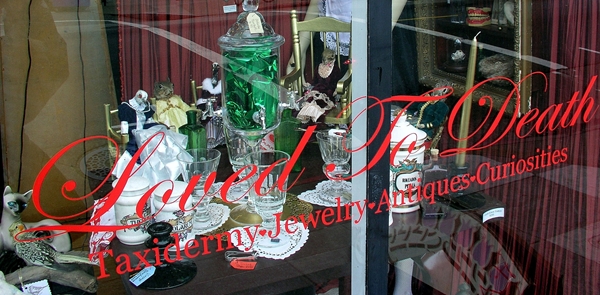
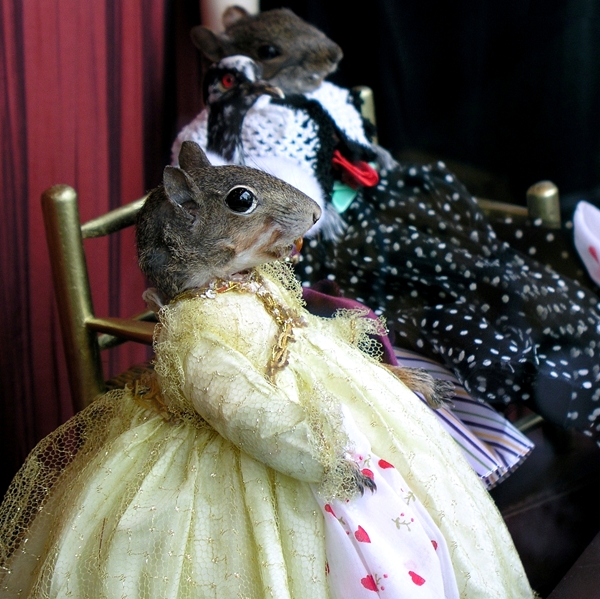
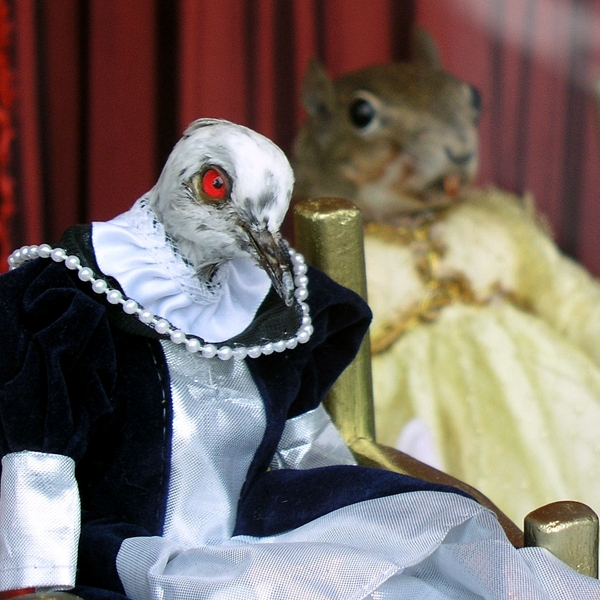
There are few things that signal spring as brilliantly as the Philadelphia Flower Show. I’m planning to arrive one afternoon this week only 90 minutes after leaving New York City by bus. I’ve made the trek each year for several years, but didn’t last year because the day I’d set aside turned out to be the worst travel day of the year in New Jersey. Blizzard conditions lowered the speed limit to 20 mph on the New Jersey Turnpike that afternoon. A big disappointment. Understand that normal snow falling, even pouring rain, is no problem, as the Convention Center is only a couple of blocks from Philadelphia’s Greyhound station. Never been? You should go! This year’s theme is Passport to the World, and the show runs through next Sunday. Here are some of the visions I saw in 2007.
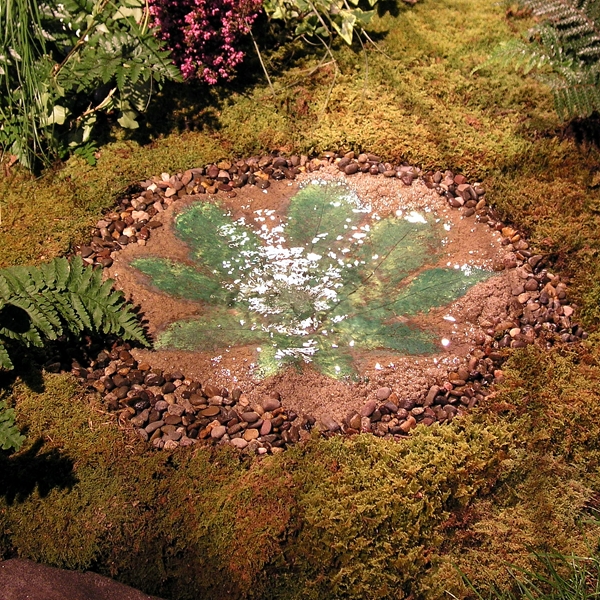
The show’s theme in 2007 was Ireland and its gardens. Each show has acres of displays by landscape firms from around the country, every one showing creative ideas. Above is a simple recirculating fountain with a totally natural look.
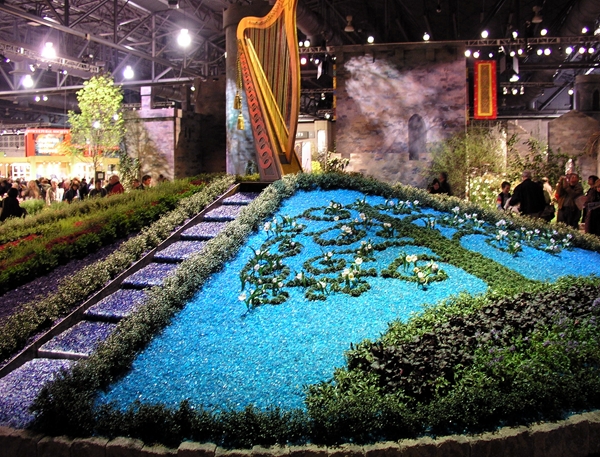
This massive display showed what can be done in the garden with recycled glass.
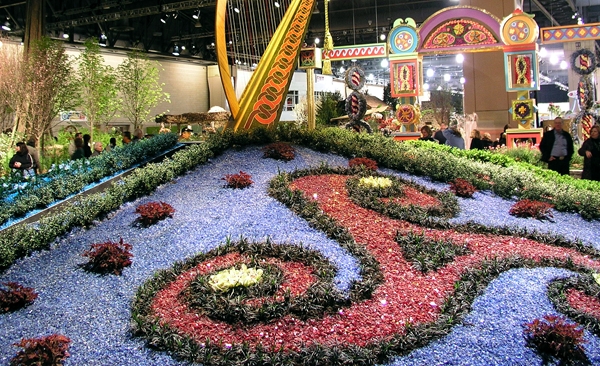
The harp and its mound greeted attendees upon entry, giving plenty of punch.
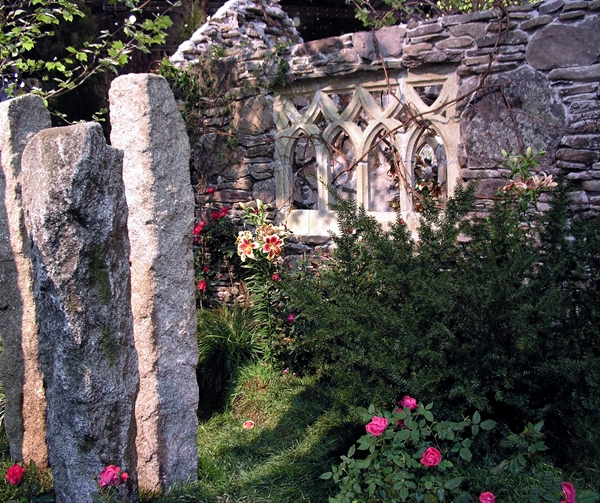
One of the most exquisite big displays was a stone church ruin with a rose garden.
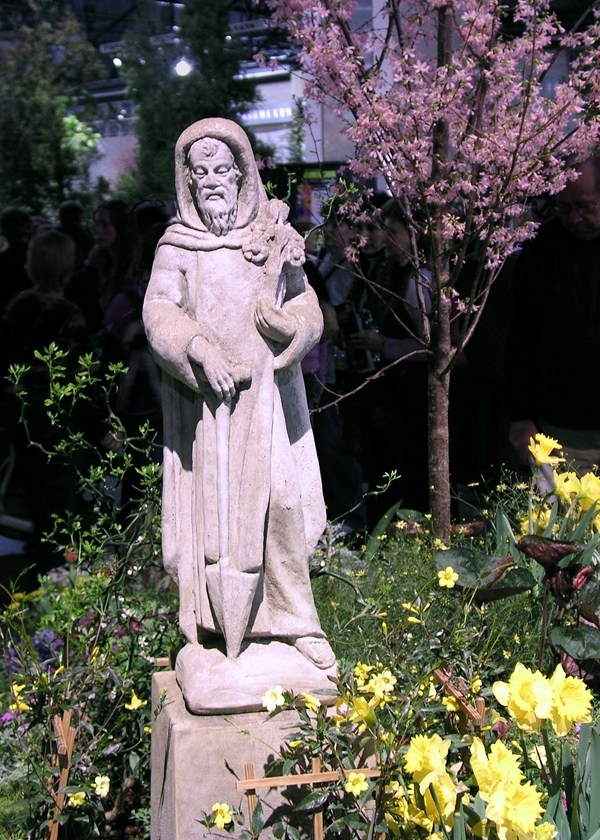
Saint Fiacre is the patron saint of gardening. He left Ireland in the 7th Century for France, where he joined a monastery. Granted a swatch of forested land, he asked for open land, and the legend says when he was told he could have as much land as he could till in one day that trees and bushes miraculously uprooted everywhere he touched the soil with his spade.
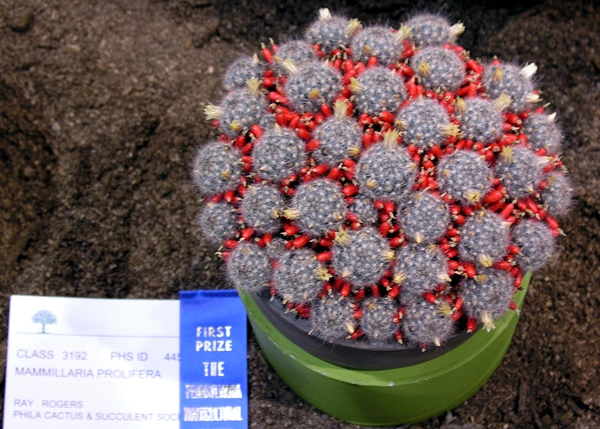
I’m including this for my friends who grow cactus. Yes, there’s a Philadelphia Cactus and Succulent Society. A good bit of the show is about competitions for best specimens, best arrangements, best table decorations, best room decorations, best miniature displays, etc. To be recognized by the judges of the Pennsylvania Horticultural Society is a great honor, and the organization works every day of the year in schools and in public education. Many displays teach conservation. The annual Flower Show is only one of the Society’s major activities.

Another winner. There’s always a plant of a kind you’ve never seen before.
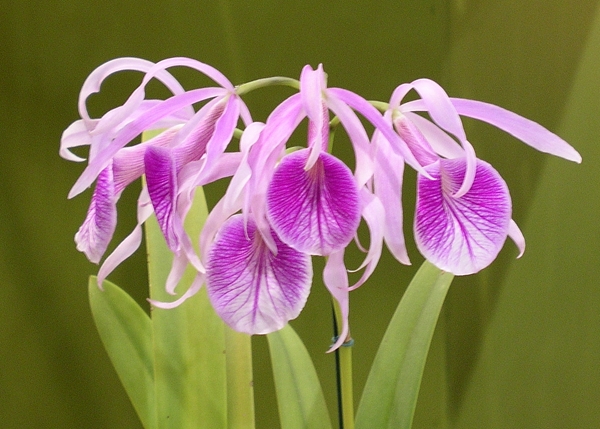
And there are always orchids of surpassing beauty.
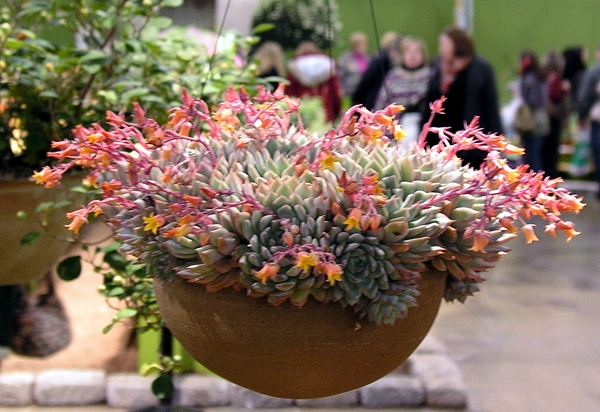
The individual plants that make the cut and are displayed can be viewed up close.
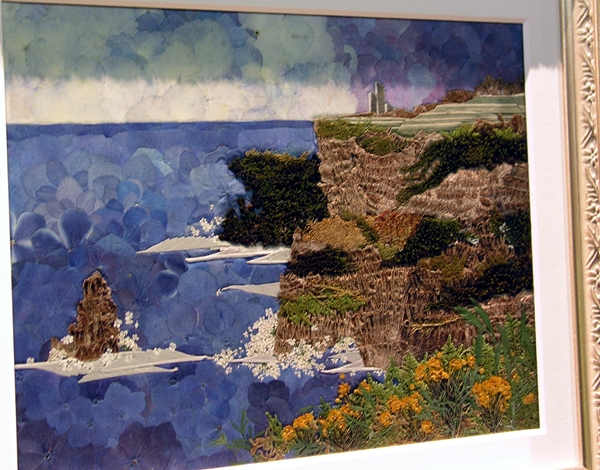
There’s also a competition for decorative arts utilizing plant materials, so there are many framed examples of pictures pieced together with petals and fibers.
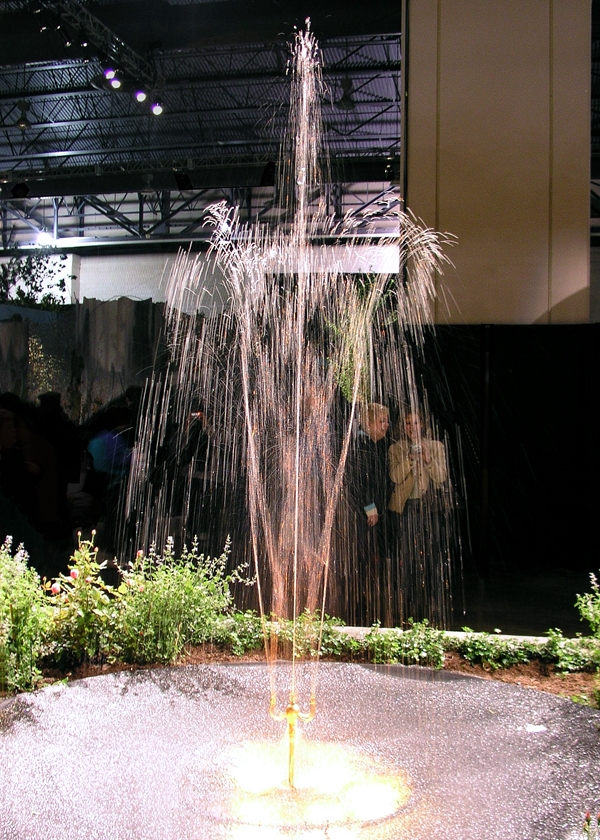
The view behind this shimmering fountain gives a sense of the size of the exhibition hall.
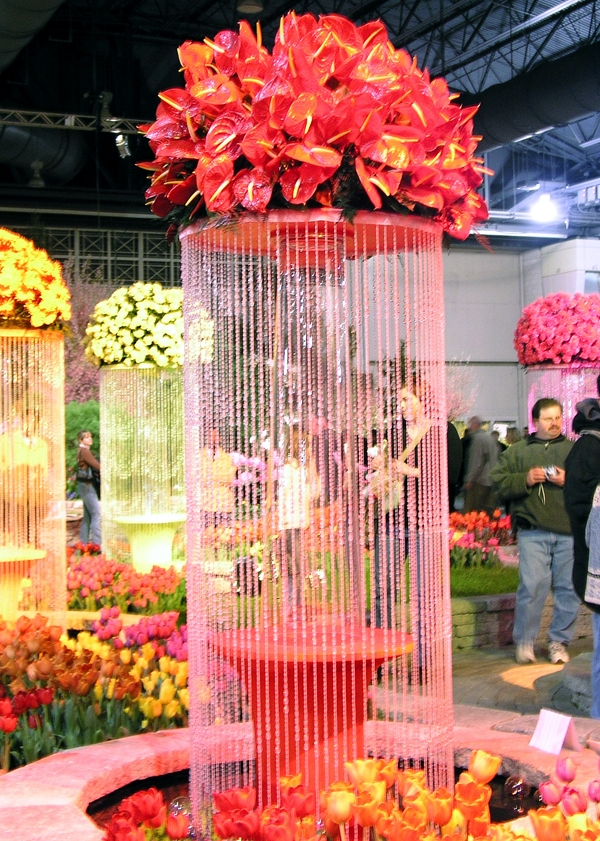
Too over the top for your taste? Keep moving. Something pleasing is just steps away.
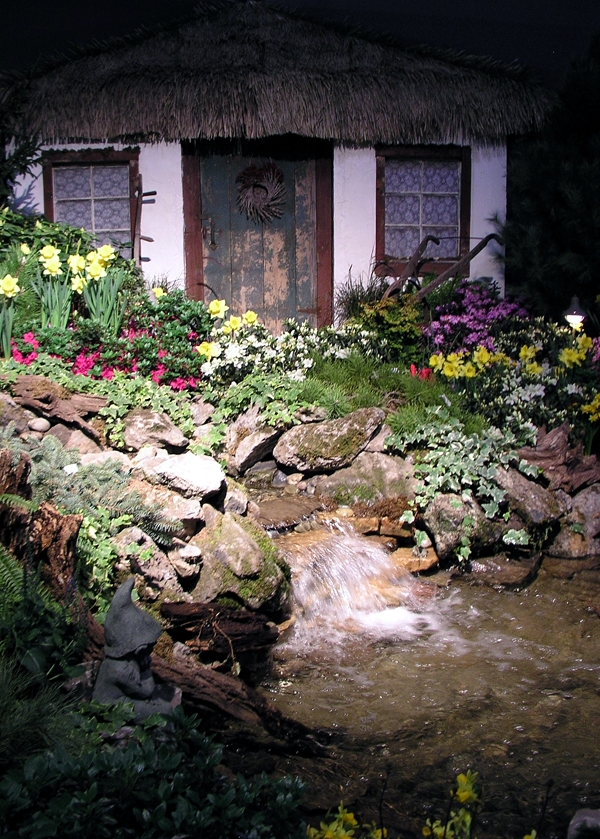
Perhaps a quaint Irish cottage with a splashing waterfall.
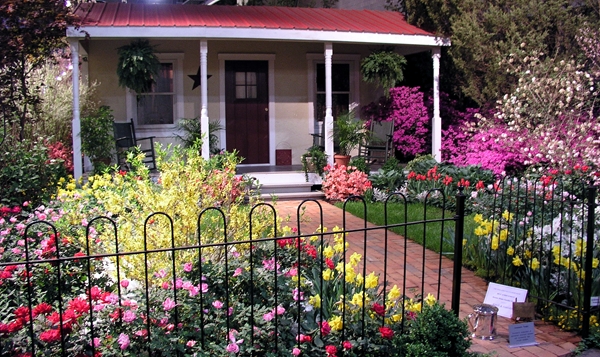
Wouldn’t you love a garden like this to welcome you home? It won a big silver cup.
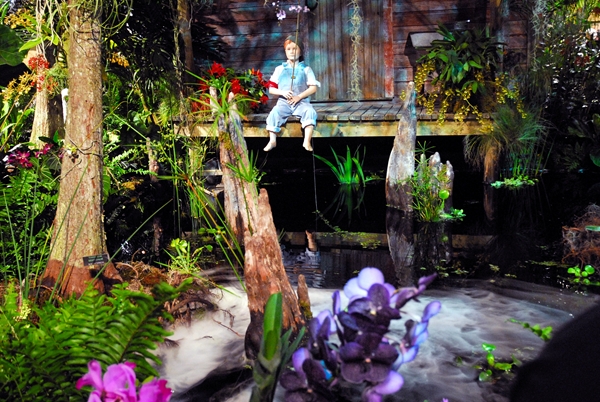
So, the first of three last photos — from 2008! The theme was Jazz and New Orleans, to give us a reminder of all the heritage that Hurricane Katrina threatened. This bayou scene had swirling fog moving on the water below the mannequin.
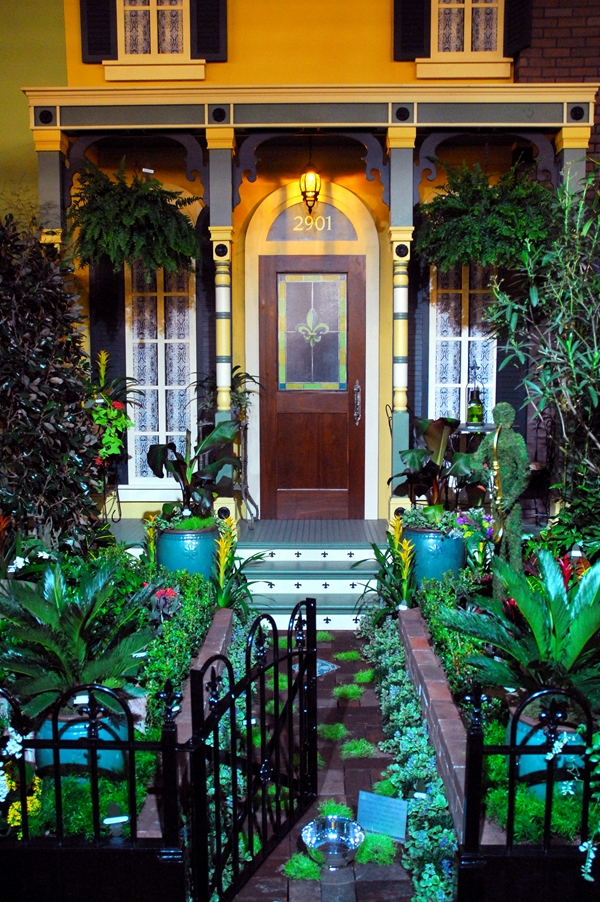
A silver bowl went to this New Orleans front yard display.
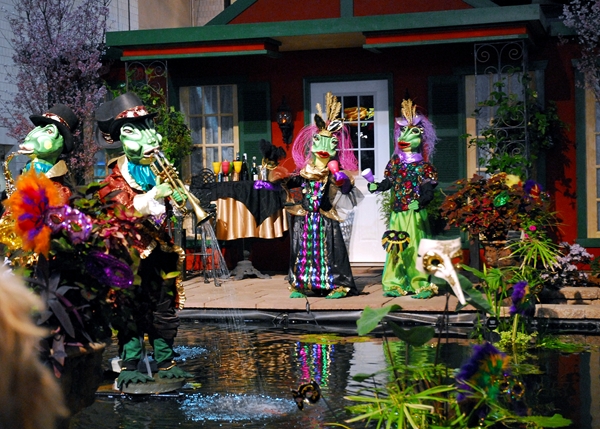
Frogs in their finery. Perhaps now you understand why I like to spend a late winter day in Philadelphia each year.
“Arizona Sunset” was printed 16 by 20 on canvas last month. I was visiting the Desert Botanical Garden, which sits among the red buttes of Papago Park between Phoenix and Scottsdale, Arizona, one recent February when I noticed an aircraft leaving a trail high in the sky. Some of the cacti at the arboretum are 80 years old, dating from before the garden’s opening in 1939. I thought an elemental contrast might prove interesting. The setting sun is at my back and illuminates this looming stand of cacti. I’m pleased with it printed on canvas. Looks great in all levels of light, and hangs in my dining room, a modernist touch in a Victorian home built a generation before the Wright Brothers ever saw Kitty Hawk, N.C.
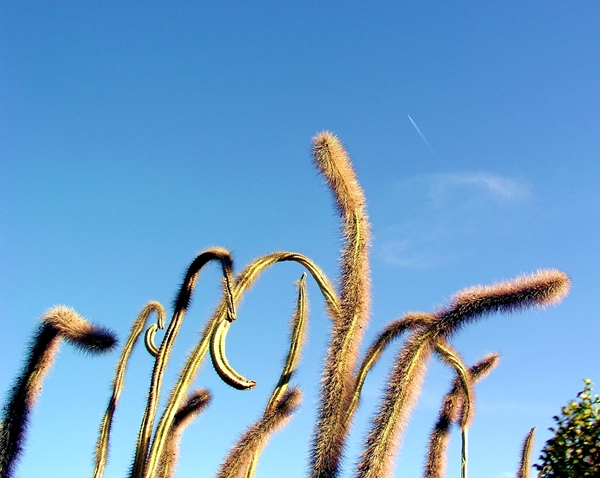
While selecting photographs to show in the 2009 Vital Voices exhibition in the Jersey City Artists Studio Tour, the influence of three master photographers seemed obvious. I’ve loved their work for decades, so I wasn’t surprised. There’s not a photographer alive whose vision has not been influenced, either directly or indirectly, by their ways of seeing.
“The Quartzsite Beauty Salon, Quartzsite, Ariz.” – The town of Quartzsite, pop. 3,354, is in western Arizona near the California border. A popular RV camping ground for winter tourists, its gem and mineral sellers and more than a dozen general swap meets attract more than a million people a year to the only town on the interstate between Phoenix and California. It was a bright February day when I stopped there for lunch at a just-the-basics restaurant, and across the street was a beauty parlor waiting for business to walk through its door.
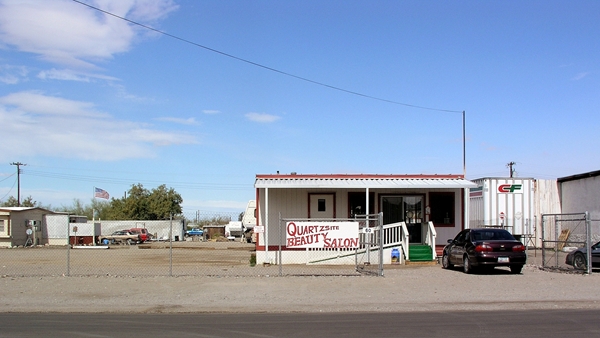
Revered for finding quiet beauty in unadorned people and small-town architecture, Walker Evans was born into wealth and was educated at Phillips Academy and Williams College before dropping out and spending a year in Paris, then joining the New York art crowd. He is best known for documenting rural life and poverty during the Great Depression for the Farm Security Administration. His book with the author James Agee, “Let Us Now Praise Famous Men,” focused on three sharecropper families in southern Alabama, was published in 1941. His 1938 show at the Museum of Modern Art was the first the museum devoted to a single photographer; it staged another comprehensive exhibit in 1971. Walker Evans died in 1975, having spent several years teaching at Yale after writing and editing for 20 years at Time and then Fortune magazine. Except for 1,000 negatives owned by the Library of Congress and in the public domain, the Metropolitan Museum of Art owns the copyright on all of his works in all media. He is quoted as saying his goal as a photographer was to make pictures that were “literate, authoritative, transcendent.”
“Calla Lilies, San Francisco, January 2009” – It was raining when my plane landed and in my first walk around my friends’ neighborhood I spotted these callas, still wearing raindrops, growing in a cement trough squeezed between the driveway and front staircase of an otherwise ordinary home.

Considered the quintessential woman photographer of the 20th century, Imogen Cunningham’s first job out of college in 1907 was making platinum prints in the darkroom of Edward S. Curtis. The photographer whose work documented the lives of the various North American Indian tribes operated one of the most successful portrait studios in Seattle. Cunningham’s independent college study had focused on chemistry and optics, as photography was such a young medium that there were no courses discussing “vision” or “expression.” It was Pictorialism – doing in dreamy, soft-focus photos what painters had been doing – that was the dominant photographic style. Always on the cutting edge even as she raised three children and operated her own successful Seattle portrait studio, Cunningham by the early 1930s was a leading Modernist photographer, a co-founder of the Group f/64, which valued sharp focus and helped bury the Pictorialist style, and her iconic studies of magnolia blossoms and other flowers, as well as nudes, movie star photos for Vanity Fair, and industrial landscapes, moved the medium during the 1920s, 1930s and 1940s. In 1945, Cunningham accepted a teaching position in the first fine art photography department at the California School of Fine Arts, and continued to take photos until shortly before her death at 93 in San Francisco in 1976.
“The Pennsylvania Woods” – In my photo shot from a walkway at Falling Water, the Frank Lloyd Wright house, we are looking down, across and up into a wilderness area that is under the protection of the Western Pennsylvania Conservancy.
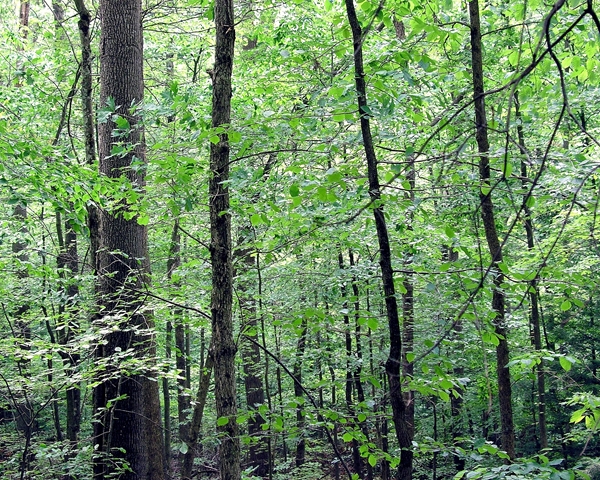
From the 1940s through the 1970s, Eliot Porter’s nature photography set new standards in color photography, and in presenting the natural world, at a time when most “serious” photographers were limited to black and white and color was considered “too literal.” Porter’s entire body of work, and in particular his first book for the Sierra Club, “In Wilderness Is the Preservation of the World” (1962) with text from Henry David Thoreau, gave early momentum to the modern conservation movement. Porter died at age 89 in 1990, and bequeathed his professional archives, containing 10,000 prints, 84,000 color slides and transparencies, and 4,400 black and white negatives, to the Amon Carter Museum in Fort Worth, Texas. A biography and a review of a book about Porter can be found here.




























